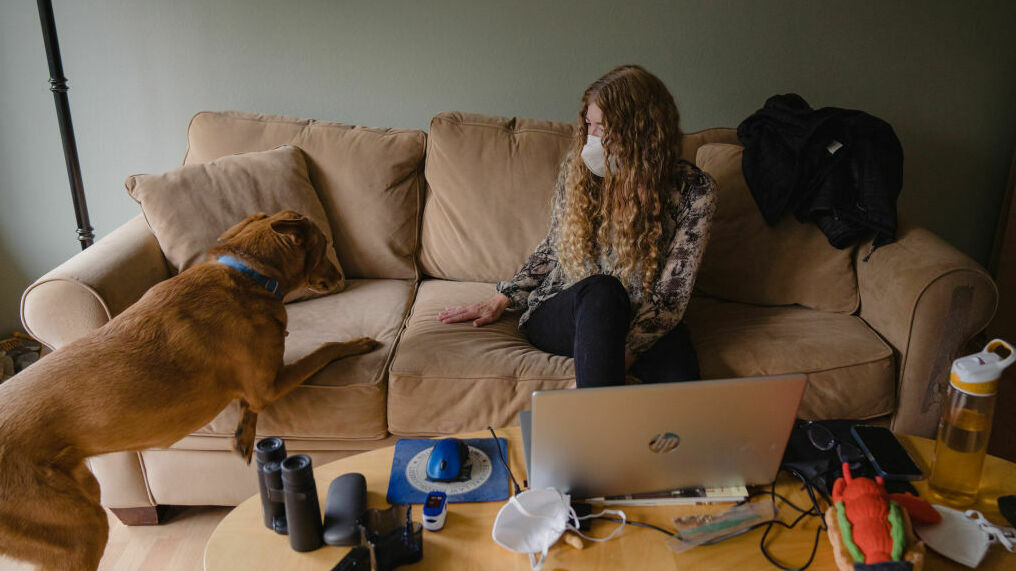



Long COVID — lingering symptoms that can follow a COVID diagnosis — afflict millions of Americans. This may be less likely after a second episode of COVID than after a first. For those who live with it, it can be debilitating. Judy Schafer, 58, met a group of other women with long COVID via Zoom at her home in Seattle, Washington, in January. Jovelle Tamayo/The Washington Post via Getty Im hide caption

Long COVID — lingering symptoms that can follow a COVID diagnosis — afflict millions of Americans. This may be less likely after a second episode of COVID than after a first. For those who live with it, it can be debilitating. Judy Schafer, 58, met a group of other women with long COVID via Zoom at her home in Seattle, Washington, in January.
Jovelle Tamayo/The Washington Post via Getty ImIf you have contracted COVID more than once, like many people, you may be wondering if your risk of suffering persistent symptoms from long COVID is the same with each new infection.
The answer seems to be no. The odds of long COVID — a suite of symptoms including exhaustion and shortness of breath — falls sharply between the first and second infections, recent research shows.
“It appears the risk is significantly lower the second time than the first time to develop long COVID,” says Daniel Ayoubkhani, a statistician at the UK’s Office for National Statistics, who has been studying COVID in this country for a long time.
But the risk does not drop to zero, according to the latest results of an ongoing survey of more than 500,000 people in the UK up to March 5.
“The risk of long COVID is significantly lower, … but it’s still not negligible. It’s not impossible to develop long COVID the second time around if you didn’t develop it the first time around. I think this is the key takeaway from our study,” says Ayoubkhani.

The survey tracked long COVID symptoms like fatigue, muscle aches, shortness of breath and trouble concentrating. Fatigue and concentration problems were the most common.
Of the adults in the survey, 4% reported long-lasting COVID symptoms lasting at least four weeks after their first infection, the survey found. In contrast, only 2.4% of those who had not developed persistent health problems after their first infection reported persistent symptoms after their second case.
“It’s a significant reduction in the odds,” he says.
The study did not examine why the risk of long COVID would be lower with a second infection than with a first. But Ayoubkhani says there could be several reasons.
For example, the immunity people have built up from previous infections can reduce the risk of developing long COVID from the next one. “We don’t know from our data, but it’s a guess,” he says.
Another possibility is that the study excluded those who had long COVID from their first infection, so those who did not have it during their first infection may naturally be less prone to long COVID for some reason. .
“It could have something to do with someone’s predisposition,” he says.
The study also did not examine whether a second infection worsens symptoms in people who already have long COVID.
Even though the study was conducted in the UK, there’s no reason to believe the results wouldn’t apply to the US, he says.
In fact, the findings are consistent with an earlier study that produced similar results when examining data from hundreds of thousands of patients treated by the US Veterans Administration.
This study, published in November, found that the risk of continuing to have health problems a year after contracting COVID increased from about 10% of a first infection to about 6% of a second infection.
“Undeniably, we see very, very clearly that for the second infection, the risk is lower than for the first infection,” says Dr. Ziyad Al-Aly, an epidemiologist at Washington University in St. Louis who led this study. study.
Al-Aly agrees that this may be partly due to immunity from the first infection. Another factor is that later strains of the virus appear to cause milder disease, which may make them less likely to lead to long COVID.
“When people were reinfected, they were usually reinfected with omicron, which is definitely milder,” he said, discussing his study results.
Another possible influence may be improved treatments, which have lessened the severity of COVID, he says.
Neither study looked at the risk of prolonged COVID after a third or fourth infection, but Al-Aly hopes the risk will continue to decline with each subsequent infection.
“All of these things point in the right direction, which makes me optimistic that at some point reinfection may add insignificant risks or inconsequential risks,” he says.

“That’s our hope. We don’t have data. But that’s our hope,” he says.
But Al-Aly notes that since so many people are still catching the virus, the total number of people with persistent health conditions continues to rise even though there is a lower risk of a second infection.
“I compare it a bit to Russian roulette,” says Al-Aly. “The individual-level odds of having long COVID after a second infection compared to the first are lower for any individual person.”
But he adds, “that risk isn’t zero,” and that means at a population level, we’re still seeing a growing number of long COVID cases in the community – and a growing burden on caregivers and society. .
Edited by Carmel Wroth.
